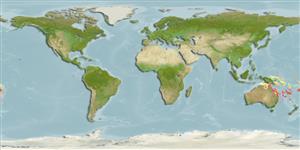>
Perciformes/Scorpaenoidei (Scorpionfishes) >
Bembridae (Deepwater flatheads)
Etymology: Bembras: Greek, bembras, -ados = a kind of anchovy (Ref. 45335); macrolepis: Named for its large body scales.
Environment: milieu / climate zone / गहराई सीमा / distribution range
पारिस्थितिकी
समुद्री ड़िमरसल; गहराई सीमा 46 - 366 m (Ref. 27966). Tropical
Western Pacific: north of Townsville to off Wollongong, Australia.
आकार / वज़न / Age
परिपक्व अवधि: Lm ? range ? - ? cm
Max length : 27.3 cm SL पुल्लिंग / अलिंग; (Ref. 27966)
पृष्ठीय रीढ़ (सम्पूर्ण) : 11 - 12; पृष्ठीय सौफट रेज़ (सम्पूर्ण) : 10 - 11; ऐनल सौफट रेज़: 14 - 15. This species is characterized by the following: head depressed; body without large scute-like spines; infraorbital bones forming a strong ridge, confluent with uppermost preopercular spine and having 4-6 spines; broad subterminal vertical band in caudal fin (Ref. 40506).
Body shape (shape guide): elongated.
Found on the continental slope. Benthic (Ref. 75154).
Life cycle and mating behavior
परिपक्व अवधि | पुनरुत्पत्ति | मछलीऔ का अंडे देना | अंडे | Fecundity | लार्वा
Imamura, H. and L.W. Knapp, 1998. Review of the genus Bembras Cuvier, 1929 (Scorpaeniformes: Bembridae) with description of three new species collected from Australia and Indonesia. Ichthyol. Res. 45(2):165-178. (Ref. 27966)
IUCN Red List Status (Ref. 130435: Version 2025-1)
Threat to humans
Harmless
Human uses
साधन
Special reports
Download XML
इंटरनेट स्रोत
Estimates based on models
Preferred temperature (संदर्भ
123201): 19.6 - 24.4, mean 21.7 °C (based on 30 cells).
Phylogenetic diversity index (संदर्भ
82804): PD
50 = 0.5315 [Uniqueness, from 0.5 = low to 2.0 = high].
Bayesian length-weight: a=0.00389 (0.00180 - 0.00842), b=3.12 (2.94 - 3.30), in cm total length, based on all LWR estimates for this body shape (Ref.
93245).
Trophic level (संदर्भ
69278): 3.8 ±0.4 se; based on size and trophs of closest relatives
Fishing Vulnerability (Ref.
59153): Low vulnerability (23 of 100).
🛈
